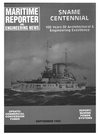
Page 81: of Maritime Reporter Magazine (September 1993)
Read this page in Pdf, Flash or Html5 edition of September 1993 Maritime Reporter Magazine
SNAME: 1893 to 1993
It was on November 16 and 17, 1893, when the first annual meet- ing of the Society of Naval Archi- tects and Marine Engineers con- vened, but the roots and making of :he society stretch much farther lack than one century.
The first texts on naval architec- ture were published in the late 17th century; and less than 200 years ater, engineering had taken the ilace of art. The shipbuilder no onger could depend solely on cre- ative efforts, prior experience and jmpirical rules. Marine engineer- ng is, of course, a much younger iranch of engineering than naval irchitecture, its earliest precepts )eing first experiments with steam- jowered vessels in the late 18th cen- tury. There were more questions inanswered than not, and the ma- terials used in marine machinery vere temperamental and unpredict- ible. Prior to the 1880s, the educa- ion of naval architects and marine sngineers was primarily by appren- iceship, a system which produced ome of the great shipbuilders of he era, including William
I.Webb, Donald McKay, Henry
Jteers, Thomas Collyer and nany others.
But as architecture and engineer- ng grew in difficulty, mainly the esult of the introduction of iron as i material of construction, it was ound necessary to introduce spe- ialized curricula in the nation's olleges, and this led to the estab- ishment of marine-related courses t many top institutions. And as apid developments in the propul- ion arena, for one, took place, there /as a growing need for a forum to iscuss and exchange technical in- ormation. lerchant and Naval Shipping
The composition of the U.S. mer- hant fleet in early 1893 gives clues hat point to neglect. At that time, tie nation's steam and sail vessels f more than 1,500 gross register ins, and built during the previous 0 years, amounted to 231 ships rith an aggregate tonnage of 54,418. A total of 106 sailing ves- sls were of predominantly wooden instruction from yards in Maine. »f the 125 steam vessels, iron and teel construction accounted for no sss than 119 vessels. Of the 114 essels built in this country, no less lan 106 came from the Big Three lipbuilders, John Roach, William ramp and Harlan &
Collingsworth. In total, only six ards built these ships: the Big hree as well as Pusey & Jones, altimore Shipbuilding and New- irt News.
The U.S. entered the 1890s with ily a few yards able to build mod- ~n, efficient, steel-hulled vessels.
But as discouraging as merchant lipbuilding appeared, the state of aval construction was even worse, s late as the early 1880s, the en- re serviceable U.S. Navy included 3 iron-clad monitors, and a variety wooden-hulled, square-rigged mboats dating back to and before
NAME Centennial the Civil War. Meanwhile, Euro- pean nations were quickly amassing modern iron- and steel-hull, state- of-the-art fighting ships. It was in 1882 that Congress authorized the reconstruction of the Navy, based on the suggestions of a 15-member ad- visory board headed by William
H. Hunt, President James A.
Garfield's Secretary of the Navy.
The result was a program for four ships, the "ABCD" vessels "Atlanta," "Boston," "Chicago" and "Dolphin."
Contracts for all four were awarded to John Roach for the building of the "new navy."
NOTE: The preceding, abbrevi- ated history of the events leading to the formation of SNAME was ex- cerpted from the first chapter of a book written by William DuBarry
Thomas, entitled "Speed on the
Ship." The book is free to registrants at the Centennial Meeting.
In her 112 years, the
Elissa has survived wars, hurricanes and even Greek smugglers.
And International has protected her through it all.
COURTAULDS
COATINGS
On her maiden voyage in 1877, the
Elissa was protected by the founding company of International. Today this 202-foot iron barque still sails with
International coatings, above and below the waterline.
Our long history with specialty boats includes developing products for all operating conditions and vessels, from fishing boats to passenger vessels to work boats and barges.
International offers a full range of standard and specialty coatings for the specialty boat owner/operator such as: Interprime universal primers;
Interfine anti-rust stain for finish coats; Intershield anti-abrasion coatings; and antifoulings for every service including Interspeed System 2, a tin-free Controlled Depletion
Polymer (CDP) coating which provides state-of-the-art antifouling protection without the need to blast to near white metal —to name just a few.
International believes every boat is just as special as the Elissa. Contact us for comprehensive coating informa- tion for your vessel.
International Marine Coatings 2270 Morris Avenue/Union, NJ 07083/TEL.: (908) 686-1300/
Fax: (908) 686-3048
International
IS and "International" are trademarks of Courtaulds Coatings.
Circle 1 on Reader Service Card 82A
The Elissa is owned and operated by the Galveston Historical Foundation.

 80
80

 82
82
